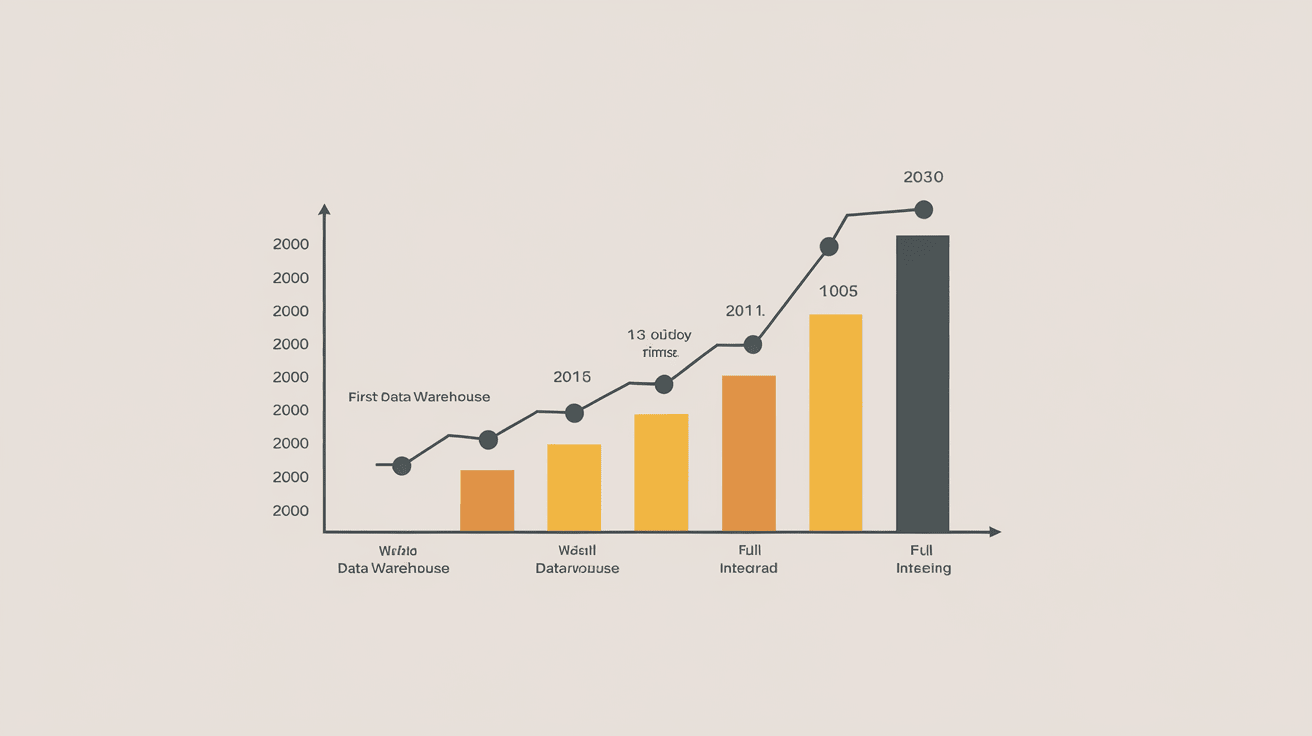The Evolution of Data Warehousing in the Banking Sector

Introduction
Data warehousing has played a pivotal role in the evolution of banking technology. As banks handle enormous volumes of data—from transactions and customer interactions to regulatory compliance and risk assessments—the need for robust, scalable, and efficient data storage and processing solutions has become imperative. The shift from traditional on-premise data warehouses to cloud-based, AI-driven, and real-time data processing solutions has transformed how banks operate, offering enhanced decision-making capabilities, risk management, and customer personalization.
This article explores the development of data warehousing in the banking sector, covering historical advancements, benefits, challenges, real-world applications, and future trends. We will also examine how leading banks and FinTech firms are leveraging modern data warehousing solutions to improve operational efficiency and compliance.
Understanding Data Warehousing in Banking
1. What is Data Warehousing?
Data warehousing is the process of collecting, storing, and managing structured and unstructured financial data from multiple sources to support analytics and business intelligence. It enables banks to:
- Consolidate customer data for better insights and fraud detection.
- Streamline regulatory reporting and compliance.
- Improve risk assessment through predictive analytics.
- Enhance personalized banking services.
2. Why is Data Warehousing Critical for Banking?
Banks generate massive amounts of data from various sources such as:
- Customer transactions.
- Credit scoring and risk management reports.
- Regulatory filings and compliance records.
- Fraud detection algorithms and security monitoring.
A well-designed data warehousing system helps banks:
- Enhance decision-making with real-time analytics.
- Improve data governance and security.
- Optimize business intelligence (BI) reporting.
The Evolution of Data Warehousing in Banking
1. Traditional On-Premise Data Warehousing
- Early banks relied on legacy data warehouses housed in on-premise data centers.
- These systems required large IT infrastructure investments and had scalability limitations.
- Challenges: High maintenance costs, slow data processing, and difficulty in integrating with modern banking technologies.
2. Enterprise Data Warehousing (EDW) for Centralized Banking Data
- Banks began adopting Enterprise Data Warehouses (EDW) to centralize financial data across different departments.
- EDWs improved data standardization, regulatory compliance, and analytics capabilities.
- Example: JPMorgan Chase implemented an EDW for better financial risk assessments.
3. Cloud-Based Data Warehousing
- Modern banks are migrating to cloud-based data warehouses like Google BigQuery, AWS Redshift, Snowflake, and Microsoft Azure Synapse.
- Benefits: Scalability, cost-efficiency, real-time data processing, and enhanced security.
- Example: HSBC adopted Snowflake for its cloud-based financial data analytics.
4. AI-Driven and Real-Time Data Warehousing
- AI-powered data warehouses enable banks to predict customer behavior, detect fraud, and automate compliance monitoring.
- Real-time analytics allow instant transaction monitoring and faster loan approvals.
- Example: Bank of America uses AI-driven data warehousing for real-time risk management.
Key Benefits of Modern Data Warehousing in Banking
1. Improved Decision-Making and Business Intelligence
- Enables data-driven strategies for risk management and customer retention.
- AI-powered predictive analytics help optimize financial forecasting.
2. Enhanced Data Security and Compliance
- Ensures secure storage of financial data through end-to-end encryption.
- Supports compliance with GDPR, Basel III, CCPA, and PCI-DSS regulations.
3. Seamless Integration with FinTech Solutions
- Allows seamless integration with AI-driven banking apps, RegTech, and fraud detection systems.
- Supports blockchain-based data validation for enhanced transparency.
4. Real-Time Analytics and Risk Management
- Enables instant fraud detection and transaction approvals.
- Provides real-time market trend insights for investment and asset management.
5. Cost Efficiency and Scalability
- Cloud-based warehouses reduce infrastructure costs.
- Scalable solutions accommodate growing financial data volumes.
Real-World Applications of Data Warehousing in Banking
Case Study 1: JPMorgan Chase – AI-Driven Risk Management
JPMorgan Chase leverages cloud-based data warehousing to manage vast financial datasets, enhancing its real-time fraud detection and risk assessment capabilities.
Case Study 2: Citibank – Cloud-Based Compliance Analytics
Citibank adopted AWS Redshift for real-time regulatory reporting and compliance monitoring, reducing operational costs.
Case Study 3: HSBC – Customer-Centric Banking with Big Data
HSBC integrates Snowflake and AI analytics to offer hyper-personalized banking services to its global customer base.
Challenges in Data Warehousing for Banking
1. Data Security and Cyber Threats
- Financial data breaches can lead to fraud and regulatory penalties.
- Solution: Implement zero-trust security models and multi-layer encryption.
2. Legacy System Integration Issues
- Many banks struggle to integrate modern data warehouses with old IT infrastructure.
- Solution: Use hybrid cloud-based approaches for seamless migration.
3. Regulatory Compliance Complexity
- Banks must comply with GDPR, CCPA, and financial industry regulations.
- Solution: Automate compliance monitoring with AI-powered RegTech solutions.
4. Scalability and Cost Management
- Expanding data warehouses while managing costs is a challenge.
- Solution: Opt for serverless cloud-based warehousing solutions.
Future Trends in Data Warehousing for Banking
1. AI-Powered Predictive Analytics
- AI-driven models will enhance risk management, fraud detection, and financial forecasting.
2. Blockchain-Enabled Data Warehousing
- Blockchain technology will ensure data immutability, security, and transparency.
3. Hybrid Cloud Data Warehousing
- Banks will adopt hybrid multi-cloud solutions for better flexibility and compliance.
4. Federated Learning for Privacy-Preserving Banking Analytics
- Federated learning will allow banks to train AI models while maintaining customer data privacy.
Expert Recommendations for Banks
- Adopt AI-Powered Data Warehousing – Deploy AI for fraud detection and predictive analytics.
- Ensure Regulatory Compliance – Leverage RegTech solutions to automate compliance monitoring.
- Invest in Cloud-Based Data Warehousing – Migrate to Google BigQuery, Snowflake, or AWS Redshift.
- Enhance Data Security Frameworks – Implement zero-trust security architecture and blockchain verification.
- Optimize Real-Time Data Processing – Utilize streaming data analytics for faster decision-making.
Conclusion
The evolution of data warehousing in banking has significantly enhanced operational efficiency, risk management, and customer experience. From legacy on-premise systems to AI-driven cloud-based solutions, banks are leveraging advanced data warehousing technologies to stay competitive in the rapidly changing financial landscape.
With innovations like AI, blockchain, and federated learning, the future of banking data warehousing is set to become more secure, scalable, and intelligent. Banks that embrace these technologies will lead the way in data-driven decision-making and customer-centric financial services.
#DataWarehousing #BankingTech #AIinBanking #CloudBanking #BigData #FinTech #RegTech #MachineLearning #CyberSecurity #FinancialAnalytics

Introduction The rapid growth of digital banking, financial technology (FinTech), and data-driven decision-making has created a pressing need for scalable…

Introduction: The Role of Data Analytics in Loan Approval The financial industry is undergoing a digital transformation, and data analytics…